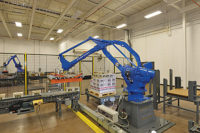In the interest of creating a more efficient warehouse, reducing cost, and improving speed, 74 percent of warehousing, manufacturing and distributing professionals surveyed last fall by the MHI Automation Alliance said they are planning or considering an automated project for their facility, according to MHI, Charlotte, N.C. Of these, 17 percent plan to invest in automated guided vehicles (AGVs), it adds.
Although originally used in manufacturing applications, AGVs now are playing a significant and growing role in supporting material movement in warehousing and distribution, says Mark Longacre, marketing manager for JBT Corp., Chalfont, Pa. Most commonly, AGVs are playing a role in storing and retrieving full pallets from block stacks on a warehouse floor or from high-density racks, he says.
“There is a general trend in the warehousing industry to only use labor for operations that add value to the product,” Longacre says. “Moving materials does not add value, so incorporating AGVs for material movement allows companies to redeploy that labor to other operations that add value to the product.”
As warehouses embrace new ways of moving materials, they’re also converting to new ways of storing the materials to maximize warehouse space while protecting product, Longacre notes. “Specific to the beverage industry, the reduction in plastic bottle wall thickness is reducing the number of block stacking warehouse applications and increasing the number of warehouses with racking,” he says. As companies make this conversion, AGVs offer flexibility by being able to move pallets of product to and from block stacks, racks and other automated storage equipment as well as standard trailers, he adds.
Fitting this flexibility bill, JBT offers a standard counterbalance forked AGV that can move pallets to and from the floor, conveyors and many types of racking, Longacre says. This AGV looks similar to a counterbalance fork lift truck, minus the operator cab, and is fitted with a single-double attachment that allows it to carry one or two pallets at a time, improving warehouse efficiency, he adds.
Scott Hinke of Dematic USA says AGVs also can serve as a flexible, cost-effective alternative to automated storage and retrieval systems (AS/RS). “The difference here is that, with using AGVs, you can create redundancy and flexibility,” the vice president and general manager of the Grand Rapids, Mich.-based company’s AGV business explains. “If you have
five aisles of, for example, some sort of racking, in an AS/RS, you would need five machines — one for each aisle. The beauty of AGVs is you can have two AGVs and service all five of those aisles, so you don’t have to buy as many vehicles.”
Dematic offers AGVs that can store and retrieve pallets in racks as high as 35 feet, says Mats Herrstromer, AGV account manager.
In comparison, with an AS/RS, if a portion of the system goes down, products in the aisle serviced by that system are inaccessible, Hinke says. However, with AGVs, any AGV can access any aisle, so their natural redundancy can allow them to step in to help the down AGV, he says.
Critical thinking
Buchs, Switzerland-based Swisslog’s dual-mode AGVs offer flexibility in another way. As both a manual and automatic device, the AGV helps decide the most efficient course of action in order to garner the most use out of the vehicle as possible, says Brad Moore, vice president of AGVPick and global accounts for Swisslog. “The dual-mode AGV (manual and automatic) allows for the vehicle to be used automatically for 90-plus percent of the pick assignments and, when the distance is best suited to have the picker drive to the next location, the AGV system recognizes the situation and recommends to the picker to put the vehicle in manual and drive,” he says.
In addition, Swisslog’s AGVPick and AGVTransport solutions provide the software for AGV systems to make intelligent decisions by always selecting the closest vehicle for the next task and sending it to the right place at the right time, Moore adds.
Beyond this higher-level decision-making, individual AGVs offer intelligent capabilities to improve performance in other ways. Greene, N.Y.-based The Raymond Corp. offers an automated lift truck with navigational learning capabilities. The Raymond Courier Model 3010 center rider pallet truck does not require lasers, tape, wire or magnets for guidance but instead is able to learn up to 15 miles of routes and navigate those routes in a matter of three to five hours, the company says. The Model 3010 is designed for automated, horizontal performance by automatically towing carts up to 10,000 pounds, it says.
To minimize vehicle downtime, JBT’s AGVs are able to change each other’s batteries, Longacre says. The company added hooks to its AGV batteries, allowing the forked vehicles to grab and lift one another’s low batteries, move them to a charging station, pick up charged batteries, and place the charged battery on the other AGV, he explains. During this battery exchange, the AGV in need of charging rests on a power plate that provides external power to the vehicle so that it does not need to be rebooted when the charged battery is attached, he says. Through this smart exchange process, the AGV in need of charging is only down for approximately three to five minutes, rather than docking at a charging station for an extended period of time, and does not require human intervention to swap the batteries, he adds. However, he notes that this system often works best in AGV fleets of five vehicles or more in order to optimize fleet performance and have a smaller percentage of vehicles involved in each battery exchange.
Standardized safety
As with any piece of technology — particularly intelligent, automated technology — customers sometimes express concerns about the safety of AGVs, Dematic’s Hinke notes. “People aren’t familiar with AGVs; people are new to AGVs, so they’re certainly concerned with the safety aspects when something is roaming around without a man on it; they really want to understand the safety of an AGV,” he says.
However, Hinke says the beauty of AGVs is that their operations are governed by controlled specifications with safety in mind. “Every aspect of AGVs has a controlled standard around it and has specific recommendations that clients should follow when deploying AGV technology,” he explains.
Dematic’s Herrstromer, who also is vice chairman of the Industrial Truck Standards Development Foundation, says the organization redeveloped its AGV standards for installation, personnel training and operations last year so that U.S. standards and European standards would better coincide with each other. For example, the old safety standard required that the distance between an AGV and a fixed object in a plant or warehouse be 18 inches, but the new standard requires a distance of 500 mm or 19.69 inches, he explains. Similarly, the organization updated some of the European safety standards for installation to coincide with U.S. standards for key factors like personnel training and vehicle guide paths. “Those kinds of things are what we have done to make it the same no matter what country you go to,” he says.
Once properly installed, AGVs can help create a safer working environment, JBT’s Longacre says. “AGV movements, including acceleration and deceleration, are precisely controlled and very predictable,” he explains. Personnel working near the AGVs quickly become very comfortable working around the AGVs because they are confident the AGVs will always be on the path and operating consistently as designed.”






